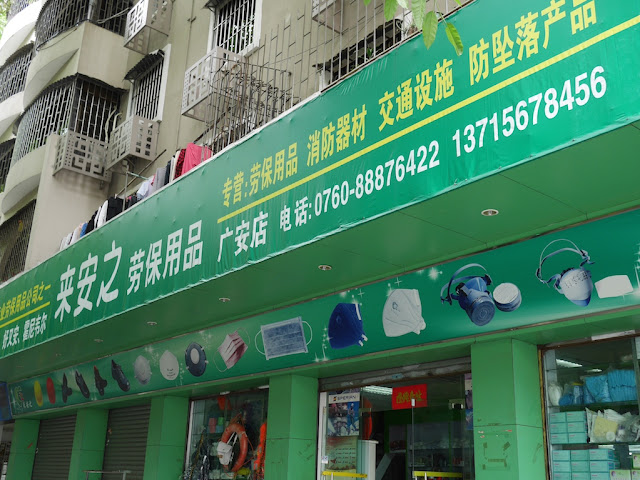For a variety of reasons, on a number of occasions I have found it challenging to figure out the name of a road in China. Two of those reasons are that online maps often lack relevant details and are sometimes incorrect. For example, based on some online maps people could question whether all of the
photos in an earlier post were really from Baisha Road as I claimed and weren't instead from Dongguan Road.
Here is how Google Maps depicts the
meeting of Baisha Road and Dongguan Road.
Google Maps China, which unlike other versions of Google Maps is accessible in China,
similarly labels the roads.
Starting from the upper right the maps indicate that Dongguan Road continues around the bend in the road. However, the first four photos in the earlier post were all taken at the bend or close to it on either side.
Part of my claim that the photos do indeed capture Baisha Road is based on something quite simple, the streets address signs on the buildings there. For example, here is a sign for 1 Baisha Road.
The location of this building neatly matches with the result to a search for the address on China-based
Baidu Maps.
As reflected above, even at the highest zoom levels, Baidu Maps doesn't display a name on the portion of road at and south of the bend (in all the maps south is "down").
Google Maps fails in a search for addresses on Baisha Road. It only returns a result for Baisha Road in general.
While the marked location is indeed on Baisha Road, it is far from 1 Baisha Road as indicated on Baidu Maps. Unfortunately, any time I have searched for Baisha Road or 1 Baisha Road in Chinese on Google Maps China I get the message "服务器错误. 请稍后重试." indicating there was a server error and suggesting to try again later. I've tried over a span of more than a week and have always had the same result.*
Like Baidu Map, the labels on China-based
Sogou Maps at its highest zoom are also ambiguous on the issue, though a Dongguan Road label is closer to the bend.
But Sogou indicates a location for 1 Baisha Road similar to Baidu's result.
Like Google Maps, Bing Maps China** shows Dongguan Road continuing around the bend.
The roads are identified similarly with English language settings and for the U.S. version of Bing Maps. Also like Google Maps, the best Bing Maps China can do for a search of 1 Baisha Road is just a general indication for Baisha Road without indicating a specific address.
Bing Maps and Google Maps also can't locate specific addresses for Dongguan Road.
To sum things up . . .
According to Google's or Bing's online map services, the scenes from the one portion of road I photographed are at Dongguan Road and not Baisha Road. They can't locate specific addresses for these two roads though.
The road labels for Baidu Maps and Sogou Maps aren't definitive one way or the other, though Sogou Maps make it look like at least a small part of the area is Dongguan Road. However, the search results for specific addresses indicate this portion of road is Baisha Road. These results match up quite well with the address signs I saw posted on buildings there.
Additionally and finally, there was one other step I took to sort things out. I asked a person working in a shop there. Without hesitation she identified this section of road as Baisha Road.
So while I wouldn't completely rule out a more complicated story indicating otherwise, the overall evidence suggests Google and Bing have it wrong and Baisha Road begins just slightly east of where Baidu Maps and Sogou Maps indicate 1 Baisha Road. While a small portion (the closest 5 meters or so of road) in the first photo might include the western end of Dongguan Road, I feel fine saying that the
earlier photos capture Baisha Road.
For added evidence and color, I will later share photos of some buildings from this section of road with posted street addresses. And in another post or two farther down the road (pun unintended), I will examine other limitations and problems, some quite disastrous, with online map services for China. Similar to this post, it will in part serve as a follow-up to a
comparison of online map services I did seven years ago. A lot has changed since then . . .
*I get the error message regardless of whether I use a VPN or not. I get the same error message for many other searches I've tried as well, though I have had success at times with some types of searches. It seems searches for specific addresses are especially unlikely to succeed, but at this point I'm not sure of the scope of the problem.
**I tested Bing Maps China at
cn.bing.com/maps while in China, using a clean browser, and without using a VPN. However if Bing identifies you as outside of China, you may be taken to another web address without the "cn". And you may need to change Bing's settings for country/region or language to achieve a similar, though perhaps not identical, experience.
Disclosure: In the past I worked at Microsoft China. My work did not cover Bing Maps.

























































